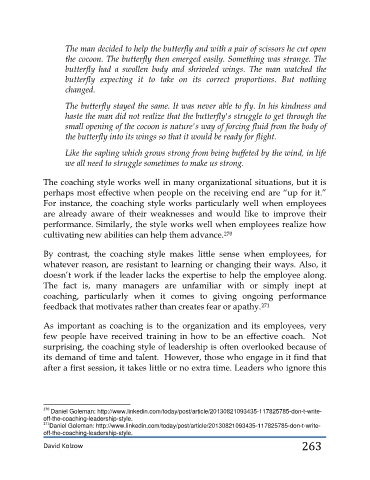Page 263 - 4- Leading_from_Within
P. 263
The man decided to help the butterfly and with a pair of scissors he cut open
the cocoon. The butterfly then emerged easily. Something was strange. The
butterfly had a swollen body and shriveled wings. The man watched the
butterfly expecting it to take on its correct proportions. But nothing
changed.
The butterfly stayed the same. It was never able to fly. In his kindness and
haste the man did not realize that the butterfly's struggle to get through the
small opening of the cocoon is nature's way of forcing fluid from the body of
the butterfly into its wings so that it would be ready for flight.
Like the sapling which grows strong from being buffeted by the wind, in life
we all need to struggle sometimes to make us strong.
The coaching style works well in many organizational situations, but it is
perhaps most effective when people on the receiving end are “up for it.”
For instance, the coaching style works particularly well when employees
are already aware of their weaknesses and would like to improve their
performance. Similarly, the style works well when employees realize how
cultivating new abilities can help them advance.
270
By contrast, the coaching style makes little sense when employees, for
whatever reason, are resistant to learning or changing their ways. Also, it
doesn’t work if the leader lacks the expertise to help the employee along.
The fact is, many managers are unfamiliar with or simply inept at
coaching, particularly when it comes to giving ongoing performance
feedback that motivates rather than creates fear or apathy. 271
As important as coaching is to the organization and its employees, very
few people have received training in how to be an effective coach. Not
surprising, the coaching style of leadership is often overlooked because of
its demand of time and talent. However, those who engage in it find that
after a first session, it takes little or no extra time. Leaders who ignore this
270 Daniel Goleman: http://www.linkedin.com/today/post/article/20130821093435-117825785-don-t-write-
off-the-coaching-leadership-style.
271 Daniel Goleman: http://www.linkedin.com/today/post/article/20130821093435-117825785-don-t-write-
off-the-coaching-leadership-style.
David Kolzow 263

